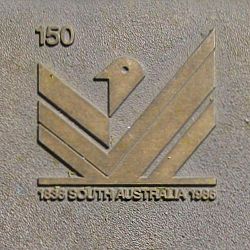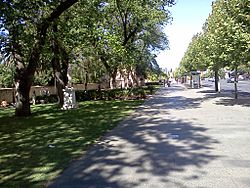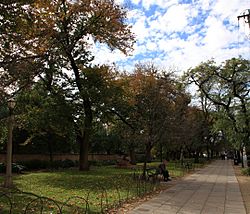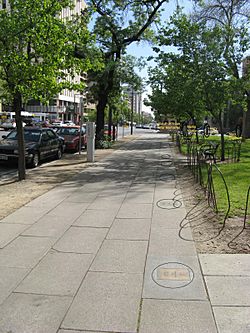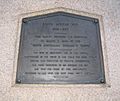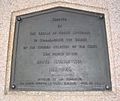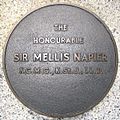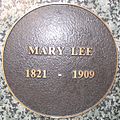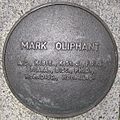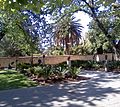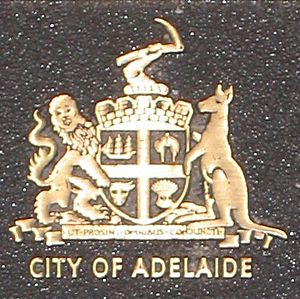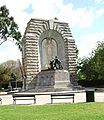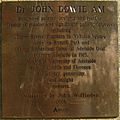Jubilee 150 Walkway facts for kids
The Jubilee 150 Walkway, also variously known as the Jubilee 150 Commemorative Walk, the Jubilee 150 Walk, and the Jubilee Walk, is a series of (initially) 150 bronze plaques set into the pavement of North Terrace, Adelaide in from to the Prince Henry Gardens. It was officially opened on 21 December 1986. It was commissioned as part of the celebrations commemorating the 150th anniversary of the founding of the Province of South Australia (by the British). The plaques contain the names and deeds of (initially) 170 people who made major contributions to the founding and development of South Australia. Since 1986, the Adelaide City Council has added four plaques.
The plaques are arranged in alphabetic order, and stretch from King William Road to Pulteney Street along the north side of North Terrace. The walkway starts at the South African War Memorial, and passes in front of Government House, the National War Memorial, the State Library, the Museum, the Art Gallery and the University of Adelaide. This portion of North Terrace also contains more than a dozen statues, busts and other memorial plaques, plus numerous public seating benches, some drinking fountains and some water features in front of the Museum and Art Gallery.
In 2011 the Adelaide City Council reorganised the area in front of Government House (between King William Rd and the National War Memorial). The plaques and the major statues were not moved, but the avenue of gas lamps was removed, the various busts were moved from King Willian Road to an area between the statues of Venere Di Canova and Matthew Flinders, and a bust of Sir Lawrence Bragg was added to the group.
Contents
- King William Street
- Kintore Avenue
- University of Adelaide
King William Street
The walkway starts near the corner of North Terrace and King William Street, in front of the front gates and gatehouse of Government House. The very corner is occupied by the South African War Memorial. Also on that corner, starting from the gatehouse and walking SE, were (prior to 2011) the busts of Sir Thomas John Mellis Napier, Mary Lee and Sir Mark Oliphant, all of whom have plaques on the walkway. These busts have been moved further east to the vicinity of the bust of Lord Florey, between the plaques for Kate Cocks and Sir Walter Crocker, and been replaced by the first six plaques of the walkway and seating.
Start of the Walkway
Plaques: Angas – Bagot
-
Sir Henry Ayers
South African War Memorial
South African Boer War Memorial by A Jones 1904
Government House
This section of North Terrace in front of Government House has been named the Price Henry Gardens.
Prior to 2011, running along the fence of Government House, there was an "Avenue of Gas Lamps". This has been replaced by a broader footpath.
Plaques: Bagshaw – Bonython
Statue of Dame Roma Mitchell
The Honourable Dame Roma Mitchell, modelled by Janette Moore, sculpted by John Woffinden and Sally Francis, unveiled 1 July 1999.
Plaques: Bradman – Cawthorne
-
Sir Donald Bradman
Statue: Venere Di Canova
Statue of Venus (Venere di Canova) donated by W. A. Horn in 1892. Somewhat controversial at the time of its unveiling in 1892, this piece was the first of Adelaide's street statues. It is a copy in Carrara marble of the statue of Venus by Antonio Canova – the original is at the Pitti Palace in Florence. (Photo of the original.) – Pedestal of Sicilian and Kapunda marble. Executed by Fraser & Draysey. Presented by Mr W. A. Horn. Unveiled 3 September 1892, by His Worship the Mayor (F.W. Bullock, Esq.).
Plaques: Chapman – Cocks
Busts
Prior to 2011, the bust of Lord Florey stood alone in this portion of the Price Henry Gardens. The bust was completed by John Dowie in 1969, and unveiled by the Right Honourable the Lord Mayor (Robert E Porter, Esq.) on 25 June 1969.
After the 2011 reorganisation of the area, the bust of Florey was joined by the busts of Oliphant, Lee and Napier relocated from King William Street, and new busts (of Sir Lawrence Bragg and later Sir William Henry Bragg) were added to the group.
The three busts in their pre-2011 locations:
Sir Thomas John Mellis Napier by John Dowie, 1970.
Unveiled by His Excellency the Governor-General of Australia, The Right Honourable Sir Paul Hasluck, C.M.G., G.C.V.O., K.St.J, 2 July 1970.
Mary Lee by Pat Moseley.
Sir Mark Oliphant by John Dowie, 1978.
Five busts in 2013. Six busts in 2017
Plaques: Crocker – Dickinson
Statue of Matthew Flinders
Captain Matthew Flinders by F. Brook Hitch, A.R.B.S. Pedestal of Murray Bridge red granite from Kirchel's quarry at Swanport. Paving of Tea Tree Gully freestone. Architect, A.E. Simpson, I.S.O., F.R.A.I.A. (Architect-in-Chief of subscription.) Unveiled 12 April 1934.
Plaques: Duguid – Gerrard
-
Sir Thomas Elder
National War Memorial
National War Memorial – Great War – 1914–1918 by Woods, Bagot, Jory & Laybourne Smith; and Rayner Hoff, 1931.
Although the National War Memorial was initially proposed as a memorial to those who served in "The Great War", the site has since grown to incorporate a number of smaller memorials. These include a memorial to the Battle of Lone Pine; the "French Memorial", which commemorates those who fought and died in France during the first and second World Wars; an honour roll of those who died in World War II; and the "Australian Armed Forces Memorial", encompassing the Malayan Emergency of 1948–1960, the Korean War, the Indonesia-Malaysia confrontation in Borneo, and the Vietnam War. In addition, the wall which surrounds the northern and western sides of the site features the six "Crosses of Memory" – a series of "simple wooden crosses" commemorating the Siege of Tobruk from 1941 and the 10th, 27th, 48th and 50th battalions of 1916.
-
Lone Pine and battle.
-
South-East Asia and Korea
Plaques: Gibb – Gill
-
Sir Claude Gibb
-
WWI VC recipients:
Blackburn, Davey, Inwood, Jensen, Leak, Sullivan, Weathers, Woods -
WWII VC & GC recipients:
Derrick, Gosse, Kibby, Matthews
Kintore Avenue
The Institute building
Plaques: Gosse – Hall
Statue of Edward VII
Huge bronze statue of Edward VII by Sir Bertram Mackennal, K.C.V.O., R.A.
Pedestal designed by sculptor. Paid for by public subscription. Unveiled 15 July 1920.
Plaques: Hancock – Hartley
State Library of South Australia
-
Robert Burns by WJ Maxwell 1894
The statue of Robert Burns bears the honour of being the first statue carved in Adelaide. It was presented by the Caledonian Society, and unveiled on 5 May 1894 by the Chief of the Caledonian Society (Hon. J. Darling, M.L.C.).
Plaques: Hassell – Hill-Ling
-
Sir Robert Helpmann
-
Sir Hans Heysen
Mortlock Library
Plaques: Holden – Jolly
Museum of Natural History
Plaques: Kavel – Mitchell
-
Sir George Kingston
-
Colonel William Light
-
Sir Douglas Mawson
Art Gallery of South Australia
Plaques: Mitchell – Oliphant
-
Peter Nelson and Marjorie Jackson Nelson
-
Sir Mark Oliphant
University of Adelaide
Mitchell Building
Plaques: Playford – Short
- Playford – Price
-
Sir Thomas Playford
- Statue of Sir Walter Watson Hughes (1803–1887)
- Ramsay – Short
- Statue of Sir Samuel Way
- The Right Hon. Sir S.J. Way, Bart., P.C, D.C.L., LL.D. by Alfred Drury, R.A., A.R.C.A. 1924
- Designed by Walter Bagot, F.R.I.B.A., F.R.A.I.A. Erected by J. Tillett.
- Pedestal of granite. Paid for by public subscription. Unveiled 17 November 1924.
Elder Conservatorium of Music
Plaques: Simpson – Stow
Statues of Sir Douglas Mawson and Sir Thomas Elder on Goodman Crescent in front of the Elder Conservatorium
-
Sir Edward Stirling
Bonython Hall
Plaques: Strange – Todd
Napier Building
Plaques: Tolmer – Wright
-
Sir Robert Torrens
-
Pioneer Vignerons:
Johann Gramp, -
Pioneer Vignerons:
Thomas Hardy,
Ligertwood Building
Last Plaque
- End of Walkway
- Emily Potter, "How can you live in a city of monuments?": Reading Commemoration and Forgetting in Adelaide's North Terrace Precinct, Altitude vol 2, 2002.
- "S.A.'s greats : the men and women of the North Terrace plaques", edited by John Healey, Historical Society of South Australia, 2001. nla, UofA, UofA catalogue, Historical Society of SA. Reprinted 2002. Reprinted 2003. ISBN: 0 9579430 0 8 (Note that James Park Woods VC is missing from this book.)
- "South Australian biographies, 1980", Blue Book of South Australia : Biographies Australia, 1980. nla
- "Biographical index of South Australians 1836–1885", editor: Jill Statton, South Australian Genealogy and Heraldry Society, 1986. nla
- Stewart Cockburn, "Notable lives : profiles of 21 South Australians", Ferguson Publications, 1997. nla
- Stewart Cockburn, "The patriarchs", Ferguson Publications, 1983. nla Back cover sub-title: The lives and philosophies of 30 distinguished South Australians.
- "Late picking : vintage Jubilee 150", edited by Stella Guthrie, South Australian Council on the Ageing, 1986. nla


